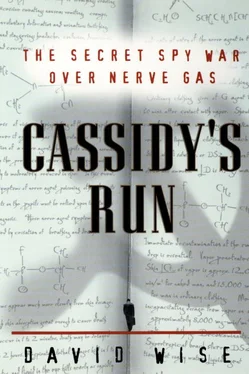Phosgene chokes its victims and can cause death by asphyxiation. It was also rumored among the scientists at Edgewood that GC was a code sometimes used in military medical records for gonorrhea.
Iraqi scientists working for Saddam Hussein reportedly developed a nerve gas that is an analogue of GH, using isobutyl alcohol.
The precise way that binary nerve-gas weapons work is classified, but scientists familiar with them said that as the shell is fired, the contents push back in what is called a setback. The setback ruptures the disk that keeps the two chemicals apart. The rotation of the shell in the air mixes the two components. By the time the shell nears the target, the chemicals have mixed and produced nerve gas.
The FBI’s official intelligence glossary defines disinformation as “carefully contrived misinformation prepared by an intelligence service for the purpose of misleading, deluding, disrupting, or undermining confidence in individuals, organizations, or governments.” Leo D. Carl, The International Dictionary of Intelligence (McLean, Va.: International Defense Consultant Services, 1990), p. 110.
The Department of Defense has declined to make any comment about Operation SHOCKER. For four years, the United States Army Intelligence and Security Command (INSCOM), in Fort Meade, Maryland, insisted in response to several Freedom of Information Act requests by the author that it had “no record” of Operation SHOCKER under that or any of the several other code names used for the operation over more than two decades. As far as the army was concerned, it never existed. At the author’s behest, Kenneth H. Bacon, Assistant Secretary of Defense for Public Affairs, asked the secretary of the army, Togo D. West, Jr., whether any information about the operation could be released. West ordered a review. On May 27, 1997, Bacon responded to the author, saying that the files had indeed been located but remained classified and would not be released. When subsequently pressed, Bacon said, “There is a security issue here.” He declined to elaborate.
Strecker was assigned from 1965 to 1968 to the army’s Office of the Assistant Chief of Staff for Intelligence (OACSI, but often called just ACSI and referred to in-house as “ohax-see” or “ax-see”). His successor was Taro Yoshihashi.
In 1985, Polyakov was betrayed to the KGB by the CIA’s Aldrich H. Ames, and three years later he was executed.
Although Danilin did not explain why the microdots were in plain text and the SW encoded, the logic was not hard to follow. If one of the hollow rocks left for Cassidy was somehow found-by a child playing, for example-the finder would not see the microdot, and the piece of paper would appear blank. Encoding the text of the SW provided another layer of security.
The dictionary had 413 pages set in two columns of type. The Soviets instructed Cassidy that the first three digits indicated the page number, always between 100 and 413, the fourth digit indicated the column, and the last two digits indicated the placement of the word.
Now, however, the code became a little more complicated. Because the fourth digit of his birth date was number 5, the number given to Cassidy always had a 5, 6, or 7 as the fourth digit, so that the sum when added to 5 would indicate column one or two. For example, one actual message Cassidy received contained the number 135685, which, added to his birth date, produced 198205, which meant the word “last.” The next number was 249692, which, added to his birth date, resulted in 312212, which led to the word “Saturday.” The message also included 152685, which, when added to his birth date, produced 215205, indicating the word “March.” Thus the numbers were part of a message scheduling a meeting in New York City for the last Saturday in March, 1975. The code was laborious to translate, but it worked.
Select Committee to Study Governmental Operations with Respect to Intelligence Activities, United States Senate, 94th Congress, vol. 1, “Unauthorized Storage of Toxic Agents,” p. 19. The dart, which the CIA preferred to call “a nondiscernible microbioinoculator,” was fired by a noiseless dart gun, accurate up to 250 feet. The victim would feel nothing when struck, and no trace of the microscopic dart would be found through any later medical examination of the dead person. The agency also stockpiled cobra venom.
Charles L. Hatheway, “Toxigenic Clostridia, ” Clinical Microbiology Reviews 3 (January 1990): 71.
Whether the information about ricin was passed to the Soviets, either in the deception phase of SHOCKER or in a separate, parallel counterintelligence operation, is not clear. In 1985, Vitaly S. Yurchenko, a senior KGB official, told the CIA about Special Lab 100, a laboratory in Moscow where KGB scientists developed and tested poisons for operational use. The Russians may have thus extracted ricin on their own.
Formerly Stalingrad, the river port city was devastated in World War II, but the surrender of Hitler’s forces there in 1943 was the turning point for the Soviet army, which then went on the offensive along the eastern front.
In both the United States and Russia, the chemists in the pilot plants typically worked with small quantities and attempted to devise the processes that would take place in a full-scale plant. In a full-scale production plant, chemical engineers turned out nerve gas by the hundreds of pounds or tons. At Edgewood, nerve gases were tested initially in a process laboratory, even before the work moved to a pilot plant.
Pinacolyl alcohol combined with methyl phosphonofluoridate creates soman, or pinacolyl methyl phosphonofluoridate. The second chemical component of soman is identical to that used in sarin; only the alcohol is different.
Mirzayanov’s theory about why the fish died might be correct, but full-scale production of soman had not yet begun in 1965, the year the fish kill occurred. The electrolysis plant that was needed to produce the necessary pinacolyl alcohol was still under construction at the time, and major production of soman at Volgograd did not begin until 1968.
In May 1961, John M. Doar, an official of the Justice Department’s civil rights division, was on the scene in Montgomery when the Freedom Riders were beaten with baseball bats and lead pipes at the Greyhound bus station. Doar also went to St. Jude’s to investigate the threats against the hospital. Sister Miriam greatly admired Doar “because he protected St. Jude’s. John spent part of one night by the switchboard with me listening to the threats. He had a set of earphones and could listen to the calls coming in.” In 1974, Doar was counsel to the House Judiciary Committee that voted to impeach President Richard Nixon.
In From Russia with Love, Ian Fleming, the creator of James Bond, popularized SMERSH as “the official murder organization of the Soviet government.” In fact, during World War II, the Soviet army did have special units called SMERSH to spy on the armed forces, liquidate disloyal elements, and track down Nazi agents.
The KGB went out of existence after the collapse of the Soviet Union in December 1991. In Russia, the spy organization split into two principal parts: The Russian foreign intelligence service, the old First Chief Directorate, became the Sluzhba Vneshnei Razvedki (SVR), which carries out espionage abroad. The Federal Security Service (FSK, later the FSB) became the successor to the KGB’s internal-security and counterintelligence departments.
Читать дальше












